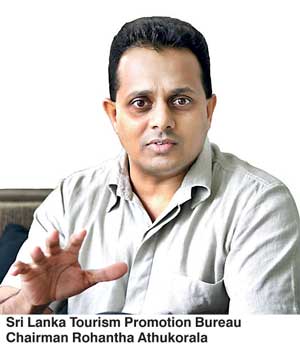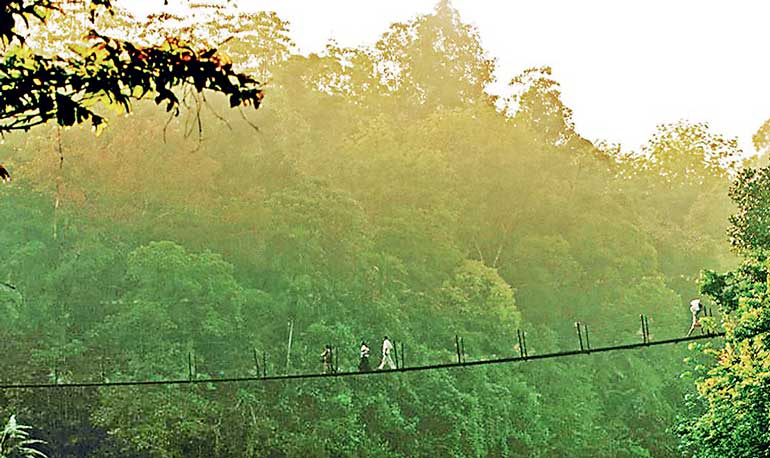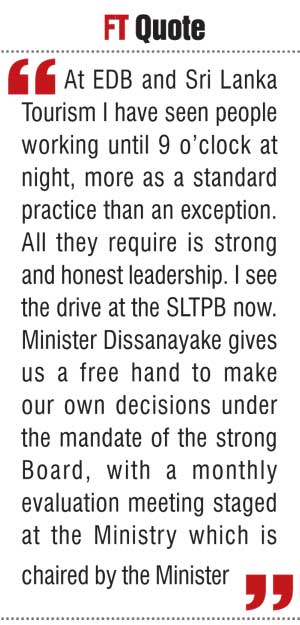Saturday Dec 14, 2024
Saturday Dec 14, 2024
Wednesday, 3 June 2015 00:00 - - {{hitsCtrl.values.hits}}
Sri Lanka Tourism Promotions Bureau Chairman Rohantha Athukorala shares key insights on the new promotional strategy of Sri Lanka Tourism in an exclusive interview with the Daily FT
Q: What are the key highlights of Tourism Promotion Strategy 2015?
A: The appointment of a global ad agency/PR agency after a lapse of five years for the development of a clear positioning to build on the good work done before. The positioning must be at every touch point where a potential traveller engages Sri Lanka’s tourism DNA – its diversity, compactness and authenticity as a tourist destination.
I like the promise of ‘8 wonderful experiences in 8 wonderful days’ which hinges on the creative hook of ‘An island of thousand treasures’, which was a pitch made by an ad agency in 2008 which came out positively even in consumer research but was never used. We have started using this in our global road shows since May 2015.
A digital partner was appointed so that conversion could be made closer to the changing global traveller. Currently around 25 million people have googled Sri Lanka in 2014 but only 1.5 million people have visited it. There have been around 55 million visitors to TripAdvisor seeking information about Sri Lankan hospitality but we see the conversion on arrivals at 1.5 million. We must track and find a way to increase conversion so that we can fill the new room inventory coming up in the next three years which is roughly 3,500.
Currently we are concluding discussions with three probable parties in the digital sphere. This medium will not only help big operators but also SMEs given that Free Independent Travellers (FIT) are reaching 35% of the market at any given moment. This is an interesting development.
In 2015 we will focus on 18 key markets and drive awareness towards decision-making through middlemen in the travel trade using traditional media while digital media will be used to build a relationship with the end traveller.
Another focus is the recruitment and training of 30 new directors/executives to the frontline. They can support markets heads who have been building the tourism business of Sri Lanka in focus markets. We are here to serve the industry; not only big companies but also SMEs. This is part of the 2015 strategy and I am very excited about the new talent we have been able to attract to the SLTPB because I always work on the principle that the institution runs better when we are not just sitting in our chairs.


Q: You are almost starting from scratch. What about the deadwood amongst the current cadre?
A: The private sector, policymakers and armchair critics must understand the reality we are up against. To be honest I am sad for this country as the industry’s market cap has increased by 199% since 2009; strategic development of the industry has not occurred. I would be failing in my duty if I didn’t thank the new Board of Directors appointed by Minister Navin Dissanayake, who goes beyond the call of duty to put the basics back in place. It’s a tough life to be honest; working 18 hours a day. I am prepared to do this for the country.
On the cadre issue, I have served in the public sector before as the Chairman of the Sri Lanka Export Development Board and as the head of a pivotal policymaking body, the National Council for Economic Development (NCED) at the Ministry of Finance and Planning for almost eight years. My humble view is that there is no such thing as deadwood. All public sector officials are graduates from top Sri Lankan universities. Their capacity to think is strong.
At EDB and Sri Lanka Tourism I have seen people working until 9 o’clock at night, more as a standard practice than an exception. All they require is strong and honest leadership. I see the drive at the SLTPB now. Minister Dissanayake gives us a free hand to make our own decisions under the mandate of the strong Board, with a monthly evaluation meeting staged at the Ministry which is chaired by the Minister.
The momentum is encouraging but I accept that we have a long way to go given the issues at hand and what the industry has been up against during the last five years. Some in the private sector say that after many years they have once again started visiting the Tourism Promotion Bureau. It’s quite a sad situation but the good news is that it’s behind us now. We need to leave the past behind and focus on the future, which is very bright for Sri Lanka Tourism given the exciting strategies that we have planned.
Q: But there are media reports alleging corruption amounting to Rs. 600 million and some have been asked to provide evidence to the Financial Crimes Investigation Division (FCID). Is this true?
A: Yes, this information is correct. Some issues with the previous administration are being investigated and handed over to the relevant officials for further action while others are being analysed internally by the Board of Directors as per Government procedures. Many officials are currently being called to the FCID regularly to give evidence and two of these officials’ passports have been impounded.

Q: So how do you manage to work effectively?
A: That’s the reality and I guess as a contemporary leader these are the challenges one faces in today’s political economy which are not only unique to Sri Lanka but faced by many countries around the world. We view it as an opportunity, as a new team can be built with a new culture but on the base of the good work done at some point in the past. The private sector worked very hard and we finally have a Master Plan for 2015 approved by SLITO (Sri Lanka Association of Inbound Tour Operators) and THASL (Tourist Hotels Association of Sri Lanka). I will be talking to ASMET (Association of Small and Medium Enterprises in Tourism) this week to get their views so that they can be used for further tweaking.
Q: What are the markets the new strategy will target and what is the marketing investment we are looking at for Sri Lanka?
A: The top ten markets are India, China, UK, Germany, the Middle East, France, Russia, Italy, Australia, Japan, Scandinavia, the Netherlands, USA, Belgium and Malaysia.
In the top six markets we spend around Rs. 150-200 million each on market activations while in the remaining ones we will invest Rs. 75-125 million each, which is very strong given that we will spend another Rs. 1 billion on above-the-line media to maintain brand salience.
Over and above that there is private sector marketing investment too; not forgetting SriLankan Airlines marketing activity which means the total country Share of Voice (SOV) is strong.
Q: But that will be around Rs. 3 billion. What happens to the balance half billion reported in the media?
A: We are investing the same amount in our digital marketing campaign, domestic marketing and below-the-line work with airlines, new product development and POSM required as per market needs.
A point to note is that all the funds spent are approved by the Board, the Tender Evaluation Committee and the Department Procurement Committee, as per government regulations, before implementation.
Q: Don’t you agree that government procedures make your turnaround time in the marketplace slow, which is an issue in a dynamic industry like tourism?
A: I could not agree more, but at the end of the day these are public funds and we are only guardians for a period of time and we must move on to another job. Hence, these processes bring in accountability and responsibility to make sure there is a return.
A case in point was the investment we made in Italy for the global event Expo 2015. Sri Lanka invested Rs. 72 million, with Sri Lanka Tourism contributing Rs. 35 million with Cabinet approval. With a private-public partnership we enabled the country to sign a charter for roughly Rs. 185 million ($ 1.3 m), which will be earned back by the country within a year, which covers the cost incurred.
ROI-based investment is key to tourism promotion work. With digital media playing a larger role, evaluation can be done. With strong leadership, speed can be brought to the system. But I agree that there is some housekeeping required in order to clear up the irregularities present.
Q: Are there any new markets which you intend to develop?
A: This is one of our priorities and we have already started the process. In China we are developing a new market in Sichuan Province where there is a population of 90 million, two million of whom travel overseas.
The Chinese Government has agreed to give us the facility free for us to develop the demand chain together with the private sector. We want to get 225,000 visitors from China this year. We are once again focusing on Scandinavian countries, which are showing signs of picking up.
We are working on changing our image in Italy, which will result in a doubling of numbers given the multimedia campaign which has been activated. Milano Expo 2015 will make Sri Lanka a top-of-the-mind destination brand in this market.
Separately, we are developing a new product, the Ramayana Trail, after the statement made by the Indian Prime Minister during his visit to Sri Lanka. Given that the Scandinavian market has shown growth since January 2015 we are also focusing on it since this is something which is financially very attractive.
Q: What about the traditional markets of the UK, Germany, France and the Middle East?
A: We are using a combination of above-the-line and below-the-line strategies to attract visitors to Sri Lanka in the traditional markets you mentioned. Given the uptick generated by the Disney movie Monkey Kingdom, which has made more than $ 15 million in ticket sales in the US, we intend using it as a vehicle when the movie is launched in Europe. We want to conduct a focused blitz in cinemas which host Monkey Kingdom together with the families of the key travel and tour operators in that respective country who account for around 40% of the business, which can be used to create awareness of the ‘8 wonderful experiences in 8 wonderful days’ in Sri Lanka.
Then we have the key travel fairs like ITB and WTM that we take part in but it will be more holistic in nature.
The total expenditure on these two markets will be almost Rs. 500 million. Sri Lanka will be represented at 47 trade fairs across the focus markets. Post-ITB, we have started developing a structured evaluation process to check the impact and corrective action that need to be taken. My humble request is to give us some time to get the basics in place.
Q: What are your plans for the cruise tourism segment?
A: We had 18 cruise liners visiting Sri Lanka two years ago. Then it increased to 22 in 2014. Now it is touching 40 this year which means that around 50,000 passengers will come to Sri Lanka which opens up a new market to Sri Lanka, making it almost beat France as a source destination.
For the first time key private sector organisations under the SLITO umbrella are joining the SLTPB to participate in the Busan Cruise Fair next month where we will meet key itinerary planners of top global liners like Royal Caribbean and Celebrity while also meeting MSC. We want to make this segment attract 100,000 visitors within two years as this is a segment growing globally. Sri Lanka must ride the wave. We have to do work on the infrastructure at the port and I am happy that the Chairman of the Ceylon Shipping Corporation is working closely with us on this initiative.
Q: How much support are you getting from the private sector?
A: The truth is that the private sector was working independent of the SLTPB during the last couple of years due to the political economy at play. We came into office around four months back and the first thing we started was the joint market planning process with country-specific consultation. Industry stakeholders like SLITO and THASL are pivotal in the decision-making process and Board approval was finally gained last week after almost three months of tough work. I am thankful to the private sector and the Board for their support as things were rough at one point in time. We cannot let the SLTPB be exposed to any more external shocks. The Board is buffering it as much as possible. I will be failing in my duty if I don’t commend the leadership in the ministry.
Q: But marketing planning can never be “over”, am I right?
A: Absolutely. With SriLankan Airlines travelling to new destinations, Sri Lanka Tourism needs to latch on to this and generate more demand given that connectivity is key to tourism development. In fact this will need to be considered at the next board meeting. While we can have a broad conceptual strategy we must be flexible to change according to the dynamic environment we are up against.
Q: Why have you tied up with other state agencies like EDB, the Tea Board, etc.?
A: Given the digital age we live in, most travellers commence their travel destination planning on the net. Hence if we can attract a traveller through the treasures that Sri Lanka as an island possesses then we can make the nation brand building pillars work for tourism. I am testing this concept at Expo 2015 where all key state institutions are under one roof - EDB, Tea Board, SriLankan Airlines, BOI, National Gem and Jewellery, Craft Council and Tourism which is helping us garner strong media for brand Sri Lanka in Italy.
I want to extend this strategy at every travel fair which Sri Lanka Tourism takes part in with the private sector, which has already begun with the Ceylon Tea Boutique at every travel fair we have taken part in. We must now develop on the work done and make brand Sri Lanka as a nation worth $ 80 billion within the next year, beating the GDP value in dollars. We must work in unison so that our total country budget will have a synergistic stretch.
Q: Are you happy with Sri Lanka rising 11 places on the Global Tourism Index to No. 63?
A: Of course, but what is more important is getting the brand positioning right for Sri Lanka which will have to be refined by the new advertising agency. Also I want the formal sector to make a decent ROI.
We must also attract quality tourists rather than just focusing on quality. What’s worrying is our low score on environmental sustainability. We are 103 out of 141 countries. This is alarming given that our forest cover has dropped from 53% to 29% during the last 20 years. We must focus and correct this.
Sri Lanka Tourism is leading the initiative ‘one million tree stories’ in partnership with Rotary Sri Lanka and HNB. This must be driven harder. I am so happy that SLITO and THASL have taken the responsibility to drive this project, which was launched by Miss World Rolene Strauss, in March this year.
Q: How do the numbers stack up?
A: India will bring in 325,000 tourists followed by 225,000 from China while the UK will bring in 190,000 visitors followed by Germany with 130,000, the Middle East with 110,000, France, Australia, Italy, Scandinavia, the US and Japan, etc. The weakening of the Euro and the market collapsing in Russia is worrying for the overall numbers and profitability of the industry. But we are aiming at 1.8 million visitors this year, as agreed with the Ministry.
We must first focus on social fabrication aspects at the SLTPB so that such pressure can be absorbed. I want to get the basics right first before chasing numbers.
Q: How will you ensure that these plans will not collapse after you leave, given the uncertainty in the marketplace?
A: I always make sure a shadow responsibility is held by a technocrat who is a permanent fixture at the SLTPB. This will make sure the new initiatives will continue. I also make sure that Board direction is sought, so that the private sector can give direction to policymakers irrespective of the personalities that are in the system.
Separately, we have a calendarised market activity and expenditure plan agreed so that even a non-marketer can ensure continuity in the years to come.
Q: So what is planned for the next 60 days?
A: We plan to float the tender and appoint the new advertising agency, PR agency and digital marketing partner.
We also want to agree the positioning strategy and ensure that all marketing work - trade fairs, visiting journalist programs and above-the-line activity - targets distinctive positions and the value proposition of the brand.
We want to train the new team with global exposure from top organisations like Google and TripAdvisor and marketing specialists with international marketing experience. I want my market heads to spend more time in the overseas markets than in Sri Lanka, developing creative marketing strategies like screen-based marketing, etc. on an ROI model.
We are also looking to ensure that product delivery matches the expectations created by the SLTPB, which means working closely with hotel school and the development authorities, not forgetting the MICE market through the convention bureau champions. We must be close to the market. This is where the strength of the SLTPB will kick in.
Q: So how do you handle the criticism, given the burden you bear at the Tourism Board?
A: I have realised one thing: in Sri Lanka, everybody is a tourism promotion expert. In fact, many have very good ideas. I take the good ones and run with them, while I do accept that in the public sector one must be mature and handle negative and positive comments in the same spirit.
But one thing I will not accept is letting down the country on the global stage. This must not be allowed by any industry.
Sri Lanka’s tea industry is a classic example of an industry which passionately protects the industry image. I am proud to be part of the Tea Board Marketing Committee for the last five years and share its lessons with the tourism industry.
Q: On a personal note are you happy to serve the tourism industry as you were in fact appointed as the Chairman of the Sri Lanka Export Development Board by the Minister of Industry and Commerce?
A: I never expected this kind of a challenge after serving the UN system for almost five years. But it’s a brilliant learning process. I am enjoying the experience. Yes, I was reappointed to the EDB but I continue to serve the export industry as I serve the Ministry of Industry and Commerce as the Commission General for Expo 2015.